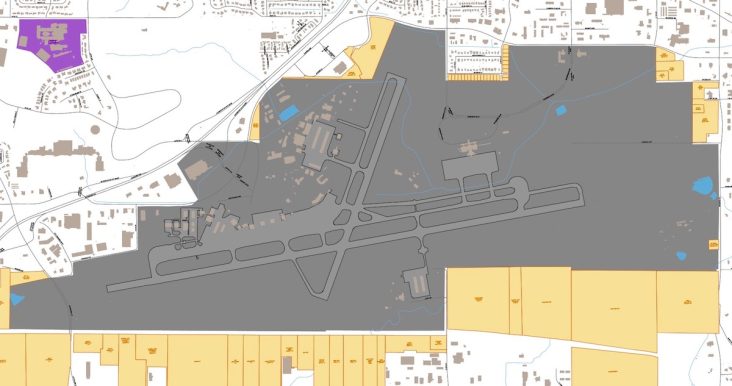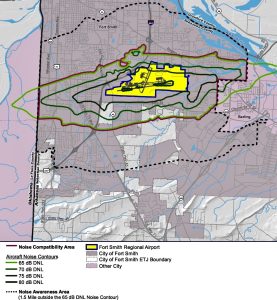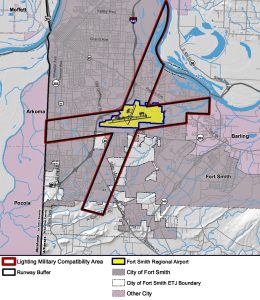Fort Smith officials hear about noise concerns, new rules related to foreign pilot training center
by April 26, 2024 2:01 pm 2,210 views

Some Fort Smith residents – including a former Fort Smith Regional Airport manager – expressed concerns Thursday (April 25) about noise levels in the city when F-35 fighter jets begin arriving this summer as part of the Foreign Military Sales program.
Ebbing Air National Guard Base, home to the 188th Wing in Fort Smith and co-located with the Fort Smith Regional Airport, was selected in March 2023 by the U.S. Air Force to be the long-term pilot training center supporting F-16 and F-35 fighter planes purchased by Singapore, Switzerland, Poland, Germany, Finland and other countries participating in the Foreign Military Sales (FMS) program. Initial estimates are that 1,500 military personnel and family members will be associated with the new center once it is fully operational.
U.S. Air Force officials have said the earliest planes and pilots from foreign nations could arrive at Ebbing would be in late 2024, part of the military’s fiscal year 2025 beginning in September 2024. The full complement of 12 F-16s and 24 F-35s from various nations could arrive in fiscal year 2026 at the earliest. It has been estimated that the full cost to create an operational foreign pilot training center will range between $700 million and $800 million.
THE ‘OVERLAY DISTRICT’
The City of Fort Smith held meetings Monday (April 22) and Thursday to get public feedback on the proposed “Military Compatibility Area Overlay District” the city developed to “protect public health, safety, and welfare of the community and preserve and maintain existing and future operational capabilities of the Fort Smith Regional Airport/Ebbing Air National Guard Base.” (Link here for a PDF from the city with details about the overlay district.)

Lighting in the area overlay district should be fully shielded and pointed downward, said Maggie Rice, director of planning and zoning with the city of Fort Smith. Search lights for advertising purposes and the use of laser source light or any similar high-intensity light, such as that used for outdoor advertising or entertainment, are prohibited in the overlay.
Noise compatibility regulations, which only applies to new construction of noise sensitive buildings, such as homes, churches, schools, nursing facilities and the like, include minimum sound transmission class (STC) of exterior walls, roof ceiling, doors and windows in particular areas of the overlay. In areas with decibel day-night average sound level (dB DNL) of 65-69 in the overlay (a complete map of the overlay is available on the city’s website) requires 39 minimum STC of exterior walls and roof ceiling and a 25 minimum STC of doors and windows. In the 75-80 dB area (closer to the airport) the minimum STC of exterior walls and roof ceiling is 49 and the minimum STC of doors and windows is 38.
FUNDING SUPPORT
City administration has said they are researching grant opportunities to help those already existing homes in the overlay areas add soundproofing to homes. They also provided information regarding certain avenues for mitigating sound retroactively. Following are those information points.
• Acoustic calk, a flexible caulk that works as a sound inhibitor, costs between $15-$100
• Replacement windows range between $300-$900 depending on type, size and design
• Window inserts, which are installed on the interior side of windows in the existing frome and help filter more noise, cost between $250-$500
• Laminated Windows, which consist of two sheets of glass with an interlayer of plastic, cost between $10-$20 per sq foot per window
• Foam plugs, which are inserted into a window’s frame to create an airtight finish and help block noise, are $25-$75
• External shutters, which are a do-it-yourself method that create a visual barrier between the outside world and the home interior, range from $70-$300
• Sound-dampening curtains range from $20-$400
• Extra insulation costs range from $1-$4 per square foot depending on type, material, etc.
• Replacement doors cost between $150-$1,000. If a door seal kit is added the cost can range from $600-$1,450 for a solid core door with a soundproofing door seal kit

Several of those in attendance at Thursday’s meeting suggested that more be done to help homeowners in the overlay area install sound-reduction amenities to their homes. For property physically contiguous to the airport, there are more stringent guidelines proposed for new construction that include a maximum height of 20 feet and a 30-foot buffer between buildings and the airport property. Also, any property to be sold to a foreign entity would require approval by the Fort Smith Board of Directors, Rice said.
These restrictions are recommended to help with military and intelligence safety, Geffken said.
“This is not related to the planes taking off or landing. It is in regards to those who may watch and learn what is going on there,” Geffken said.
RESTRICTION QUESTIONS
Rice said none of the buildings on the north side of Phoenix Avenue would have the requirements. They only relate to new construction on property that connects to the airport. She also noted that airport hangers and buildings would not have the same requirements. Suggestions from those attending included making the maximum height equal to the maximum height of any current buildings on property connecting to the airport property.
“Why would you put that restriction on the private businesses,” one attendee said. “Let the (federal) intelligence agencies take care of that. But we shouldn’t penalize the independent business owners.”
Some at the meeting also complained about what the noise from the fighter jets would do to the city and voiced concerns about the reduction in property values in the overlay area and the decline of quality of life throughout the city.
“A lot of people will be affected by the noise. This is the loudest airplane ever built in the US – 115 decibels. The F-16 is 109. Homeowners and businesses will be subjected to 115 decibels,” said Robert Johnson, former Fort Smith Regional Airport manager. “Who is going to pay when my doors and windows crack? How is the city going to help me maintain my house?”
NEXT STEPS
City administration said they were recording all the comments made at the public forums and would work to incorporate what suggestions they could into the proposed overlay district requirements. The next step for the requirements will be to update them, then take them before the Fort Smith Planning and Zoning Commission, probably in May, Rice said. Then the ordinance will go before the city board of directors, probably in June, Rice said.
The proposed requirement ordinance will be accompanied by a companion ordinance that will rescind the temporary moratorium on construction around the airport.
The Fort Smith Board of Directors unanimously approved an ordinance Oct. 24 that expanded a new residential construction moratorium near the Fort Smith Regional Airport for two more years. The ordinance, drafted in response to the anticipated military needs at the Ebbing Air National Guard Base, calls for the expansion of the land area covered by a moratorium enacted June 21, 2022, until December 2025. The expanded moratorium area allows for residential construction if the construction complies with sound attenuation standards and allows structures destroyed by fire to be rebuilt if the construction complies with sound attenuation standards.
